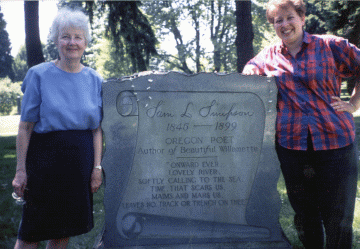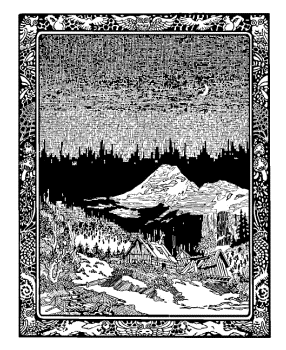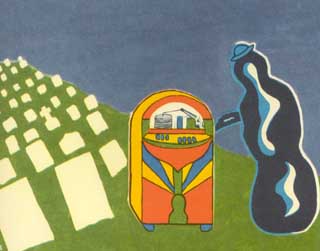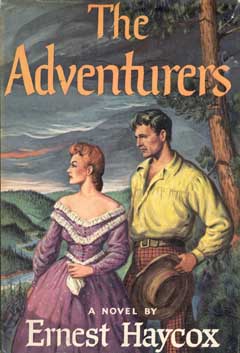A Working Chronology of
Oregon Literature – 1838 -1950
An Expanded List by OCHC Members including Tim Barnes and Rick Rubin
1838 (March)
First Oregon poem, written by Mrs. Jason Lee, a farewell to her husband Jason
Lee.
1843 Prairie
Flower, by Sidney Walter Moss, was probably the first novel written in
Oregon. An Oregon City merchant, Moss sent it east with a friend. It was
published by Stratton & Barnard in Cincinnati under the name of a
well-known author of the time, Emerson Bennet.
1846
-1855 Oregon Spectator, Oregon’s first newspaper,
printed some of the earliest poetry written in Oregon, frequently unsigned.
1852 A
Melodrame Entitled “Treason, Stratagems, and Spoils,�? by Breakspear
(Charles Lysander Adams). This political satire appeared in five installments
in The Oregonian and later as a pamphlet. Adams may have been the most
popular writer in Oregon in this era.
(April 23)
Edwin Markham born in Oregon City. The author of “The Man with the Hoe�? (1899),
the most famous poem of the Progressive Era, left Oregon at the age of five.
1854 Grains,
or Passages in the Life of Ruth Rover, with Occasional Pictures of Oregon,
Natural and Moral, by Mrs. Margaret Jewett Bailey. The first novel
published in Oregon, a thinly disguised autobiography detailing Bailey’s
difficulties as a woman missionary in Oregon.
 Sam Simpson Society officers celebrate the centenary
Sam Simpson Society officers celebrate the centenary
of the poet's death in 1999 with OCHC.
1862
The Canoe and the Saddle,
Adventures Among the Northwestern Rivers and Forests, by Theodore Winthrop, a stirring account
of a voyage from Port Townsend to The Dalles in 1853, published around the time
of the author’s death early in the Civil War.
(October 12)
“Joaquin�? Cincinnatus Hiner Miller and Theresa “Minnie Myrtle�? Dyer married in
Port Orford after a whirlwind weekend romance.
1868 Specimens,
by Joaquin Miller, his first book, was published by long-time Portland printer
George Himes.
1869 Joaquin
Miller and Minnie Myrtle divorced.
1870 River
of the West, by Frances Fuller Victor. This biography of Joe Meek, which
reads like a novel, is drawn from her interviews with the famous mountain man.
1871 Songs
of the Sierras, by Joaquin
Miller. Published in London and praised by Robert Browning, this book brought
Miller international fame.
In order to
support herself and their two children, Minnie Myrtle lectures on Miller and
their failed marriage.
1871-1887 New
Northwest, edited by Abigail Scott Duniway, Oregon’s foremost suffragette,
who wrote and serially published seventeen novels in her weekly paper.
1873 Life
Amongst the Modocs: Unwritten History, by Joaquin Miller, dedicated to “the
Red Men of America.�? “Such pictures as
these were unknown to our literature when they were written, and they stand
unsurpassed today in their largeness of movement and their mass of shade and
light.�? – Hamlin Garland
1875-1891 West
Shore, a magazine of literature, art, science, and Northwest boosterism. Published
a number of Oregon poets and poems, including Ella Higginson’s popular
“Four-Leaf Clover.�?
1883 Life Among the Paiutes, by Sarah Winnemucca Hopkins,
an account of her people.
1887 (October
22) John Reed born in Portland.
1890 The
Bridge of the Gods, A Romance of Indian Oregon, by Frederic Homer Balch.
This stilted but dramatic tale of early Oregon, for decades the most popular
Oregon novel, has never gone out of print.
1894 (October
18) Harold Lenore (H.L.) Davis born at Rone’s Mill, Oregon (in Douglas County).
1898-1911 The Pacific Monthly,
a magazine of politics, culture, literature, and opinion, published in
Portland. C.E.S. Wood is the most frequent contributor. Jack London’s Martin
Eden first appeared serially in its pages. Other contributors include: Leo
Tolstoy, George Sterling, Joaquin Miller, and Sinclair Lewis.
1899 (October
1) Ernest Haycox, dean of western writing, born in Portland.
Homer Davenport's portrait of his father, who was an inspiration for his 1910 "The Country Boy"
1900
McLoughlin
and Old Oregon, A Chronicle
, by
Eva Emery Dye. This is the first of several historical novels by the long-time
Oregon City resident. Others include The Conquest, The True Story of Lewis
and Clark (1902); McDonald of Oregon ,A Ta1e of Two Shores (1906),
about an Oregon man Ranald McDonald’s part in opening Japan to the West; The
Soul of America, An Oregon Iliad, a novel of crossing the plains and
mountains to Oregon told from a feminist perspective.
(June 14)
Sam Simpson dies.
1902 Oregon Literature, by Jacob Horner. This expansion of an 1899 pamphlet is the first Oregon history to focus on literature. His Oregon History and Early Literature (1931) enlarges on the earlier volume.
1905 Letters From an Oregon Ranch, by Katherine (Louise G. Stephens),
amusing account of homesteading in the Coast Range.
1906 Cathlamet
on the Columbia, by Thomas Nelson Strong, the passing of the tribes of the
lower Columbia River.
1908 Looters of the Public Domain, by Stephen Douglas A. Puter, a well-documented chronicle of the
timber scandals.
The
Gold-Gated West, Songs and Poems, by Samuel L. Simpson, an extensive collection of his verse.
1914 Insurgent
Mexico, by John Reed, initially published in Metropolitan Magazine,
an account of Pancho Villa and the Mexican Revolution that marks the inception
of modern journalism.
Where Rolls
the Oregon, Dallas
Lore Sharp, early Columbia River lore.
1915 Poet
in the Desert, by C.E.S.
Wood. Set in southeastern Oregon, this long poem summons the example of nature
to cure a sick society.
1916 (July)
One-act play The Game, by Louise Bryant shares the Provincetown Players
stage with Bound East for Cardiff, the first play by Eugene O’Neill. It
followed an earlier performance of Freedom, by John Reed. Performances
that season are considered the birth of modern American theater.
1918 The
Slave with Two Faces, a play by Mary Carolyn Davies, produced by the
Provincetown Players.
Six Red
Months in Russia,
Louise Bryant, the Russian revolution and events leading up to it from the
perspective of its women participants.
1919 Ten
Days That Shook The World, by John Reed. This is the famous eyewitness
account of the first days of the Bolshevik revolution by Portland-born poet and
journalist.
H. L. Davis,
of Wasco County and The Dalles, wins the Levinson Prize from Poetry
magazine for a group of poems called “Primapara.�?
1920 The
Story of Opal, Journal of an Understanding Heart, by Opal Whiteley. Reputed
to be the diary of a seven-year old girl, it became a runaway best-seller,
second only to Sinclair Lewis’ Main Street for that year. The story of
Opal Whiteley is one of the most mysterious and controversial in Oregon
literary history, and her prose some of the most delightful. Ben Hoff, author
of The Singing Creek Where the Willows Grow
The Rediscovered Diary of Opal Whiteley (1986) describes The
Story of Opal as “the most talked-about book of its time.�?
 "…the last old tumbledown this side of ridge of snags." Anthony Euwer, By Scarlet Torch and Blade
"…the last old tumbledown this side of ridge of snags." Anthony Euwer, By Scarlet Torch and Blade
1923 The Fang in the Forest,
by Charles Alexander, an animal tale set near Yachats, was his first novel.
Other books include The Spendid Summits (1925) and the highly successful
Bobbie, A Great Collie (1926). Beginning in 1920, he edited and produced
The Sunday Democrat of Albany, Oregon, a strong venue for regional
poetry and writing. His “As a Dog Should�? appeared in Collier’s and was
a 1922 O’Henry Short Story Prize winner.
The J. K.
Gill’s bookstore in Portland establishes a poet’s corner with a fireplace and a
painting of Hazel Hall on the mantel.
By Scarlet
Torch and Blade, by
Anthony Euwer of Hood River, a poet of nature and human foibles, and a talented
illustrator. Another fine volume is Friendly Firs, 1931
Skyline
Trail, A Book of Western Verse, by Mary Carolyn Davies.
1925 Paul Bunyan, by
James Stevens. A robust remaking of the Bunyan myth that brings the legendary
logger to the Northwest.
1926 Singing
in the Rain, by Anne
Shannon Monroe. One of twelve books, mostly novels, this Lake Grove resident
wrote between 1900 and 1941. She presented the story and views of Harney
County’s Big Bill Hanley in the entertaining Feelin’ Fine! (1930).
How Could I
Be Forgetting, by
Ben Hur Lampman, Here Comes Somebody (1935), At the End of the Car
Line (1942), and The Wild Swan (1947), were widely read sketches
from The Oregonian, Saturday Evening Post, Sunset and
other popular magazines.
Brawnyman, by James Stevens, is a lively account of
the early teamsters building and harvesting the west. “The jobs, fights,
travels, loves, and the immense appetite of husky young Jim Turner are as
genuine as anything in contemporary literature.�? The Independent Stevens’
humorous WWI novel Mattock appeared in 1927.
1927 Status
Rerum, A Manifesto upon the Present Condition of
Northwestern Literature: Containing Several Near-Libelous Utterances, upon
Persons in the Public Eye, by
H.L. Davis and James Stevens. This scathing attack on Northwest writing and
writing teachers, composed in Davis’ hotel room in Eugene, caused a furor in
the region’s literary scene.
Carl
Sandburg tours Oregon and meets a number of Oregon writers (Davis, Stevens,
Alexander, Albert Wetjen).
Heavenly
Discourse, by C.E.S.
Wood. Forty satires set in heaven with a laissez faire God lampoon
militarism, imperialism, prudery, prohibition, censorship, evangelicals, and
bigotry. A best-seller of its time.
1928 White
Peaks and Green, by Ethel Romig Fuller, the first book of poems by
long-time editor of Oregon verse. Others: Kitchen Sonnets (1931) and Skylines
(1952).
The Cabin at
Trail’s End,A Story of Oregon, by Sheba Hargreaves
Poems from
the Ranges, by C.E.S.
Wood, lyrics set in the Harney Country, Blitzen River area.
1930 Oregon
Detour, by Nard Jones. Set in the mythical Eastern Oregon town of Creston
(a thinly veiled Weston), the “new realism�? of the novel establishes it as the
first modern Oregon novel.
The Mountain
in the Sky, by Howard
McKinley Corning. His poems appeared in some of the finest magazines of the
day. See also These People (1926) and This Earth and Another Country
(1969).
1931 Northwest
Anthology of Verse, edited by Harold G. Merriam. This anthology features a
number of Oregon poets and is dedicated to Hazel Hall, containing eleven of her
poems.
The
Loop A Tale of the Oregon Country, by Thirteen Oregon Authors – Dean
Collins, Sabra Conner, Harold Bradley Say, Anthony Euwer, Charles Alexander,
Robert Ormond Case, Kathleen MacNeal Clark, Theodore Acland Harper, Sheba May
Hargreaves, Stewart Holbrook & Major John D. Guthrie. The foreword concludes,
“Oregon is becoming as well known for its literary output as for the excellence
of its salmon, apples, pears, lumber and livestock.�? The volume shows the
Oregon literary community having a ball together.
Fiddlers’
Green, by Albert
Wetjen, a sea tale by a hard-working Brit who lived in Oregon between 1920 and
1935.
1932 Genevieve, a Tale of Oregon, by Frederic Homer Balch,
assembled and published by Alfred Powers.
1934 The
White Headed Eagle, by Richard G. Montgomery, a thorough biography of a
father of Oregon, Dr. John McLoughlin..
1935 History of Oregon
Literature, by Alfred Powers. An invaluable and thorough account of
Oregon’s literary past, beginning before the coming of the white man. Powers
fine juveniles include a book of stories Marooned in Crater Lake (1930),
and the novels Prisoners of the Redwoods (1948) and A Long Way to
Frisco (1951).
 Night Life in Portland (Oregon), "scene of
Night Life in Portland (Oregon), "scene of gaiety and good clean fun" - Mr. Otis
Oregon
Poets, an Anthology of 50 Contemporaries, Henry Harrison, editor. Foreword by Ethel Romig Fuller.
Blue
Interval, Poems of Crater Lake, by Ernest G. Moll of Eugene, taut poetry and lovely
illustrations by Karl J. Belser. Notable also are his Campus Sonnets
(1934).
1935-1937 Northwest
Literary Review, Courtland Matthews, editor, a short-lived but worthy
literary review that featured a number of Oregon writers.
Mansions in
the Cascades, by Anne
Shannon Monroe and Elizabeth Lambert Wood (in collaboration), a fictionalized
account of life high in the North Umpqua drainage in recovery from the personal
toll of WWI.
Raymond
Carver born in Clatskanie.
1939 Ernest
Haycox’s story, “Stage to Lordsburg�? made into the John Ford movie classic
starring a young John Wayne, Stagecoach.
1940 Swift
Flows the River, by Nard Jones, has gone through a number of re-printings.
It joins his novels Scarlet Petticoats (1941) and Still to the West
(1946) in chronicling the history and drama of the Columbia River.
The Trail of
the Plow, by Marie
M. Goffin, the Homesteaders versus the Beaver Land Company, a tale of early
Eastern Oregon, “offers stirring and authentic voices�? – Mable Holmes Parsons
from the foreword.
1941 Young
Northwest, by Richard Montgomery, “a biography of the region�? through WWII,
in brief.
1941-1945 The
Illiterati, an anarchist / arts magazine and the associated Untide Press
publish William Everson, Glen Coffield and Kenneth Patchen, among others;
printed at the Conscientious Objector camp at Waldport on the Oregon Coast.
1942 Proud
Riders and Other Poems, by H.L. Davis.
The Rock and
the Wind, by Vivien
R. Bretherton, Willamette Valley railroad wars of the 1860s and ’70s.
1943 Ben Hur Lampman’s “Blinker Was a Good Dog�? is an O’Henry Short Story Prize winner.
1945 The
Last Mountains The Story of the
Cascades, by Robert Ormond Case and Victoria Case, capable writers of
regional history. See also: The Empire Builders (1949), Robert Ormond
Case and The Quiet Life of Mrs. General Lane (1952), Victoria Case.

Ken Kesey,
eleven years old, moves with his family to Springfield, Oregon.
Down in My
Heart, by William
Stafford, a memoir of this Oregon poet’s experiences as a conscientious
objector in World War II. Stafford’s Traveling Through the Dark wins the
National Book Award in 1963.
1947-1951 Gary
Snyder, whose book of poems, Turtle Island, will win the 1975 Pulitzer
Prize for poetry, attends Reed College, with Philip Whalen, Lew Welch, and Don
Berry, all significant Northwest writers.
1948 Mountain Man, by
Verne Bright. This epic poem in 24 sections tells the story of how the
descendants of Daniel Boone come to Oregon.
Big Jim
Turner, by James
Stevens, a novel of a young working man and poet in the Northwest of the early
twentieth century.
1949 The
Coming of the Pond Fish, by Ben Hur Lampman, a lively account of the
introduction of eastern species to western waters and their voracious
adaptation.
1950 (October
14) Ernest Haycox dies in Portland. After immense success as a western writer,
his first novels set in Oregon – Long Storm (1946), and the posthumously
published The Earthbreakers (1952) and The Adventurers (1954) –
reflect a major career change.
This
list will soon be expanded through the 1980s. No such compilation is ever
complete or definitive. Please send us your own brief suggestions for
inclusion, following the same format.
